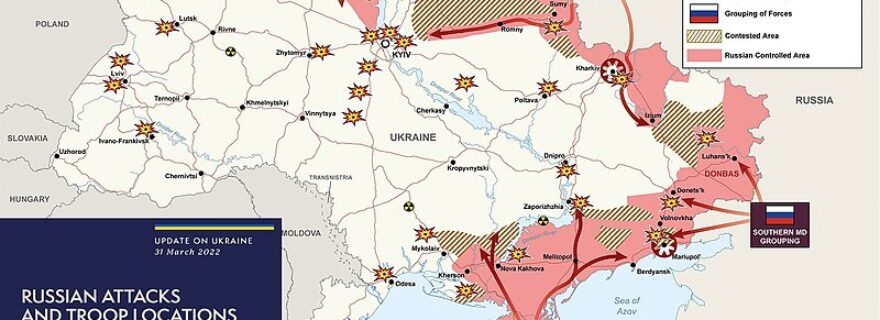Keeping Pace: The Russian Advance Rate in Ukraine in Historical Perspective
It is difficult to assess the Russo-Ukrainian War as anything but a relative debacle for Moscow, but only compared to Putin’s expectations, and pre-war analyses of how long Ukraine could resist the Russian juggernaut. Historical advance rates, however, suggest Russia is comparatively ahead of pace.
Stability Over Centuries
According to US military historical studies over the last 400 years, army rates of advance in contact have varied little despite significant changes in technology and doctrine. The caveat is that this refers to peer, comparable armies and excludes raids or reconnaissance. Pre-1990, the rate was approximately 11 km per day for lightly engaged forces, and 2 km per day for heavily engaged forces. However, the US daily advance rates in Operations Desert Storm (1991) and Iraqi Freedom (2003) were 35 km; and the Russian advance rate against Georgia was 15 km per day (2008) but again, we now know these campaigns were not against a peer competitor. One of the most important take-aways from historical advance rates is that they are largely independent of the potential speed of movement (from foot to fast-moving tanks).
Above Average
We can assess where the Russians are today relative to their starting points along the three main axes of advance in Ukraine (see table below). It is important to note that the number of kilometers advanced can vary significantly based on where the starting, or jump-off point is and which end-point is selected, but the below figures loosely average the shortest and longest distances.
Axis of Attack |
Approximate Kilometers Advanced |
Daily Rate (37 Days) |
Kyiv (from northwest) |
110 |
3 |
Kyiv (from northeast) |
225 |
6 |
East (towards Kharkiv) |
105 |
2.8 |
South (towards Kherson) |
150 |
4 |
South (towards Mariupol) |
290 |
7.8 |
The average advance rate across the Russian front according to the above figures is 7.8 km per day – still putting Russia well ahead of pre-1990 historical averages. Using these measures, we might assess Russia’s goals in terms of kilometers.
If we assess Russia obtaining a partial victory after the fall of Kyiv and other major cities, which lie about 250 km from the pre-war borders, the historical rates of advance suggest that this should take approximately 100 to 125 days – giving Russia over two more months to achieve geographic objectives at historical rates. The above figures reflect the farthest points of Russia’s advances. That Russia has, for the moment, withdrawn forces from the Kyiv thrust does not negate the other advances nor alter the possible strategic goal(s) and timeline.
Implications
Advance rates and total distance advanced are not abstract figures. They quantitatively reflect important dynamics of the battlefield and war. These include losses incurred by each side, relative firepower, possession of key objectives and terrain such as rivers and cities, and indications of an operational or strategic breakthrough. Ukraine’s objective is to minimize, or even reverse, Russia’s rate of advance. They can do this by maintaining a stiff defense, striking Russia’s logistical capabilities, and attriting Russian front-line forces. Construction of obstacles and repelling local offenses at every opportunity are key. Counter-offenses can slow down Russian advances but potentially at the cost of weakening the defense, either through losses or thinning out positions. On the other hand, a counter-offensive can also result in captured personnel, equipment and matériel, and the seizure of defensible terrain.
Russia, on the other hand, can maintain a slow but steady rate of advance by suppressing Ukrainian defenses, tactically outmaneuvering defensive positions, sufficiently supplying troops engaged in offensive operations, and simply grinding down Ukrainian forces with overwhelming firepower in the form of infantry, artillery, and – if they can be used in a way that does not result in continuously high losses – armored vehicles and tanks.
Wars can take unexpected turns which could substantially change the rates of advance for either side. For Russia, this would either be the collapse of Ukrainian resistance or amassing sufficient forces to launch another axis of attack, such as in northwest Ukraine. For Ukraine, this would require foreign armies intervening within Ukraine or a shift in Russian policy, including one caused by political upheaval in Moscow.
The Unknown Future
It is tempting to view Russia’s undeniable military errors and unmet political and operational objectives as abject failures flirting with defeat. However, history is replete with examples of the victorious side having an inauspicious beginning with failed offensives such as the federal US army in the American Civil War or the Russians in the Winter War, but a combination of strategic depth, substantial strategic resources including much larger populations, and willingness to learn from mistakes paved the route to victory. Russia today has the first two, but it remains to be seen if Putin will embrace the necessary changes to his military strategy, operations, and command.
Ukraine is not yet lost. The Ukrainians are fighting bravely and skillfully given the circumstances. The figures above, however, suggest they need to maintain their ferocious defense for at least two more months or NATO needs to intervene with boots, tracks and turbofans in Ukraine.

